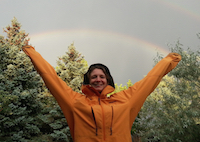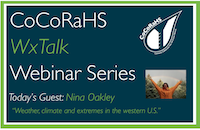|

Webinar #49 - Thursday, June 23, 2016
Weather, climate and extremes in the western U.S.
Nina Oakley
Western Regional Climate Center
Reno, NV

(biography)
The Western Regional Climate Center services 11 western states
including Alaska, Hawaii, and the US API. Our region boasts a diversity
of climates including both hot and cold deserts, temperate and tropical
rainforests, and alpine tundra. The main drivers of climate in much of
the West are its latitudinal range, proximity to the vast Pacific Ocean,
cool coastal currents, and abundance of mountainous terrain.
The West is also home to a variety of extreme weather phenomena that are
often distinct from the tornados, hurricanes, and blizzards observed in
the central and eastern parts of the country. Narrow corridors of high
water vapor transport called atmospheric rivers produce intense rainfall
and flooding when they encounter the rugged terrain of the West Coast.
Extreme terrain-enhanced winds are also a common hazard during the
passage of frontal systems. Wintertime inversions that induce hazardous
air quality are commonplace in populated basins of the Intermountain
West. Dangerous flash flooding occurs frequently in the Southwest and
Great Basin during the summer when the North American Monsoon kicks in,
and dying tropical storms have been known to brush the Southwest
inducing heavy rainfall.
This presentation will explain the drivers of weather and climate of
WRCC’s region within the conterminous US as well as explore some of its
exciting extreme events!

View the Webinar by clicking here: https://youtu.be/kWCmspgIf2s
View Nina's presentation slides  (17.1MB) (17.1MB)
Resources:
Western Regional Climate Center
|